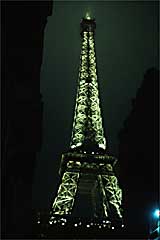|
The ad for cheap wintertime airfares to Paris grabbed our attention. It's just a fantasy to go but we enjoyed it for a couple of minutes. Board the jet in Philadelphia. Eat dinner. See a movie. We would sleep a little, be served breakfast, and land 3,000 miles away from house and children. For less money than groceries for a week we could fly to one of the most magnificent cities in the world. Being there captured our imagination. Reality set in. We haven't saved any money. The logistics of finding accommodations and making preparations conflicted with our already hectic Holiday schedules. Arranging for a friend to check in on our teen-agers would be difficult. It would be cold. We would be in Paris. We would love it. Right then and there I decided YES BUT it would be a complete surprise for my wife. I would make the arrangements myself and it would be Lynne's surprise Christmas gift. I didn't say another word. I successfully used subterfuge to get our passports. Something about being asked by work to get a passport, so we might as well both get them. Reserving the airline tickets was easy. And at $149 per person each way they were a real bargain. For the harder arrangements, I relied on friends, relatives,
children, and the telephone. Of course you can use the internet to reserve
a hotelroom but I like personal contact, and small hotels. Someone recommended
the Hotel de Nevers and showed me their brochure. I called, had a conversation
about Paris with the manager and secured a room with bath for $60 per
night. I did more research on Paris. Everything is open in the winter
and we would have lots to do. The trip stayed a great secret. 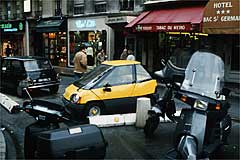
Christmas came and Lynne was VERY surprised, and happy.
Two weeks later we arrived in Paris for a 5-day stay; we were in Paris!
A train took us from the airport to the center of town. It was cold;
the skies were cloudy, the city very gray but all this made the color
leap out at us. I was in a foreign land but the unfamiliar was unthreatening.
There is an entire industry here that serves the visitor, and there
were not very many of us. I quickly shed my apprehensions and began
enjoying the moment. Next was keeping the expenses low, and discovering
what this city has to offer at a time of year when most tourists stay
away. There is much to spend your money on in Paris. Not only for tourists; the eight million residents here shop for bargains, eat in restaurants, and go out for their entertainment. Signs in store windows proclaim "Soldes-30%" or "Soldes-50%". Soldes=sale. Restaurants advertise special fixed price dinners. Discount tickets to shows and museums are for sale. Just like in the United States after Christmas, everything seems to be aimed at getting people who just spent all their money to spend some more. You need to make sense of prices to control spending. Everytime you see prices in Francs it's important to think Dollars. To convert franc prices into dollar prices just divide the number of francs by 5(80 francs=16 dollars). However, the actual exchange rate varies from 4.6 to 5.2 Francs for one dollar. How much you get for your dollar depends on where you get your money changed. Your hotel or restaurant will probably take dollars in payment but you'll get taken to the cleaners with the worst exchange rates. Even some Banks and "exchange stores" charge exorbitant commissions. We found that the area near the Paris Opera house has a wealth of exchanges to choose from. However, the rates posted outside different exchanges differed as much as 15%. We looked around and compared rates. Would you like 460 francs for your $100 or 520? For 60 Francs you can travel around Paris for several days. Spending those francs for a public transport ticket is another decision that saves money. It also helps you experience life as if you were a resident of Paris. There are high-speed rail lines, buses, and the Metro (subway). Anyone who has ever relied on public transportation in the U.S. would be delighted to use it here. The system is very well designed. Their Metro is fast, clean, and efficient. It has 13 interconnecting lines. All transfers between lines are free and protected from the weather. To do this like a pro just go to any subway ticket window and get the free transportation map of the city (le Grand Plan de Paris). (Actually the first two places we went to were out of them.) Every route is numbered and the signs in the entrances to the train platforms list the name of the stop and the station at the end of the line. After you choose your destination, write down the name of each station you need to get on and off at. If you are transferring among multiple metro lines also write down the station at the end of each line (as if you were taking each metro to the end-of-the-line). 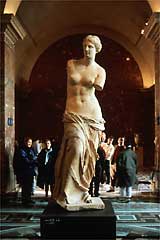
The turnstiles are tricky so it's a good idea to watch how other riders are using them. The ticket is inserted into a slot in the turnstile to enter, then recovered and used to get out the turnstile at the destination. With a little preparation, anyone who can read a map will be going down Metro escalators confidently, looking about for the right gate to enter, and be moving about Paris with the speed and ease of a Parisian. And there is so much to go to. Paris is packed with attractions. Like the Louvre. With the Mona Lisa, the Venus de Milo, and Sculpture by Michelangelo, the Louvre is a museum on the "must see" list of most tourists. The French have even found, and put on display, the walls and dungeons of the 12th Century castle that this museum was built on top of.
Paris has several new museums devoted to specific periods of Art or individual artists. 20th century Art is housed in the futurist looking Beauborg, near the Les Halles shopping district. The Beauborg is the Museum of Modern Art for Paris. It has very tall ceilings and an industrial look. Inside we saw some mediocre figurative, expressionistic, and minimalist art, as well as some good work. The beautiful Musee' de Orsay was originally a train station on the left bank of Paris. It was turned into a museum to display all the 19th Century French sculpture and Impressionist paintings that used to be in the Louvre. Lots of work by van Gogh, Renoir, Monet, Cezanne, etc. Museum evening hours also enhance art appreciation. After dinner you can make a second trip back to see a favorite work. We did this at the Louvre, and we had many galleries completely to ourselves. In several of the galleries were large sofas, so we got comfortable, and took the time to actually look at magnificent paintings. We learned not to stay for lunch or dinner at a Museum; the food is cafeteria tasting or worse. Only people who don't care or are suffering from hunger do that twice. With a multitude of wonderful, reasonably priced, uncrowded places offering delicious fare, Paris is not a place to eat poorly. I don't know what it is like when the crowds are here but off-season, the Maitre'D and waiters appear glad to see customers. We found the service courteous and food terrific. My one tip to the food sensitive person is to take a French-English dictionary and translate the entire menu item before you order it. "Ragons de Veau sauce au porto" was not veal in a sauce but it was delicious anyway and my most memorable meal in Paris. 
No one has to eat next door to any museum or hotel because Paris is so easy to travel around in. A Metro stop is probably a block or two away and the trains run 5 minutes apart. They can whisk you away to eat and bring you back. I think this is what Parisians do. I could recommend places we found, but instead suggest areas that deserve exploration: Montparnasse, Gare du Nord, and The Boulevard des Italians near the Opera. Above the metro stop of each of these there are dozens of cafes and restaurants. Go there before you're starving and walk around, read menus, and decide. In cafes and from street vendors, lower cost meals are available. They're selling sandwiches of pate on crisp French bread or varieties of crepes for less than 10 francs. Parisian workers crowd these places during the lunch hour because the food is good and inexpensive. Before noon or after 2 P.M. there are always tables available. Restaurants have great dinners that can ordered for less than 300 francs per couple, including a carafe of wine. Some advertised fixed price dinners for 75 francs. In Paris, the bill includes the 15% tip for the waiter. Window seats sometimes cost more but they add a visual treat-you watch the constant parade of Parisians outside. And they watch the people inside the restaurants.
Sunday afternoon, between the Notre Dame Cathedral and its Metro station, we found an outdoor market specializing in birds. It was a spectacle of sight and sound. Gilded cages, birdseed, and hundreds of colorful birds were for sale. I noticed that there were many boxes of flowers stored in tents behind the rows of birdcages. This is because during the week, flower vendors use the same block. We took a bus up the Champs-Elysees to the Arc de Triomphe. This arch was built by the order of Napoleon to commemorate his 96 triumphs. It is covered with friezes of these battles and the names of his generals. The Arc is something people have seen photographs of but in real life, up close, it makes a different impression.
Wandering around Paris by foot is wonderful but not a reliable way to get to any destination in a short time. There are great buildings and beautiful shop windows but what looks like only 1.5 kilometers on the map can take over 1.5 hours to traverse. The city was laid out over the last 2,000 years and there are only a few straight streets. Walking any distance usually requires zigging and zagging and constant attention to street signs and directions. No streets form any kind of parallel grid pattern. You can't make four right hand turns and assume you'll end up anywhere near your starting point. We learned this after a beautiful afternoon in Versailles, the home of the French Kings and Emperors. This huge palace was originally built in a beautiful, small, suburb of Paris but now the area is all built up and urbanized.
We decided to take the high-speed rail line back to Paris. We could see the train station down the street. Window-shopping drew us down a little street on the right. Then we came to a dead end, turned right and walked through an apartment house playground filled with children. We turned right again and walked over a pedestrian bridge across railroad tracks. We hoped we would be back on the first street but instead found ourselves deposited in back of the Versailles City Hall. Police, Fire, and emergency units are headquartered here. Employees were outside washing their trucks. The police were looking at us strangely. We quickly headed out the driveway. Neither of us wanted to understand what the person on the public address system was shouting, repeatedly. After that, we decided to look at the street map before taking any more "shortcuts". If we did get lost again, at least it would be in Paris. Occasionally, we did see "lost souls" here. There was the early morning group of disheveled men passing around two bottles in brown bags at the Gare de Nord, a large train station. They watched me as I struggled repeatedly to get my ticket to work in the exit turnstile. It wouldn't work. I began to taste my anxiety level. I backed off as the next group of commuters rushed towards me. The turnstile was broken and people simply jumped over or crawled under it. I found a working turnstile and left the men without regret.
After I accidentally ripped the shoulder off of my old jacket we decided to try finding me a new jacket. The first place to look in Paris is at the flea market of clothing vendors near the Place of the Republic. Finding the place turned out to be easy because street signs all over Paris have arrows on them that point towards nearby attractions. Here, the narrow twisting streets open up to an indoor/outdoor market for clothing. There were lots of beautiful clothing, many vendors, and few customers. And the vendors were hungry for sales. A pencil and paper were useful to have them write down the price and then make a counter offer. A calculator was indispensable to translate the cost to dollars. I almost broke our budget buying a leather jacket so I didn't. We continued to walk around this fascinating place. I did a double take at a basket of fox stoles because one seemed to be looking back at me. Then it moved. It was alive. It was a Chihuahua all covered up to keep warm. I still needed another jacket so I asked our concierge where he would go to buy one. He told us the C & A store in the Montparnasse neighborhood was advertising a big sale.
We left the C & A elated at our 250 franc purchase and the friendliness of the people. Here again, sales people seemed surprised we were foreign tourists. That day I realized we had been the exception around Paris. Several times people had asked us directions in French while we were looking at our map or remarked about our presence in their "town". I'm a person who prefers not to wait in lines, or peer around others to see art. I love to travel. But too many people get anxious/irritated in crowds. Then they take it out on the tourist workers, who then take it out on the crowds of tourists. In winter, Paris' beauty is a secret that French people are far more likely to enjoy than foreigners. If you join the crowds to Paris in the spring, you will have to put up with the crowded streets, crowded museums, crowded restaurants, and just plain crowds. Off-season is the time to go.
|
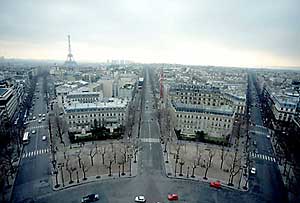
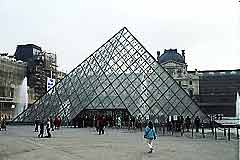 The
Lourve has a glass pyramid entrance. It also has poles and chains out
front to line up the hundreds of people who wait to get in. However,
we saw no lines outside or inside any museum. This made the art easier
to see. We could take our time and get real close.
The
Lourve has a glass pyramid entrance. It also has poles and chains out
front to line up the hundreds of people who wait to get in. However,
we saw no lines outside or inside any museum. This made the art easier
to see. We could take our time and get real close. 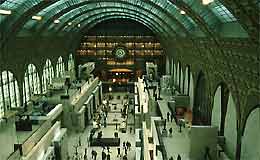 Here
we took a wonderful English language tour. Not only did our guide help
us locate the famous paintings among all the beautiful ones but she
also took us behind the scenes. We saw areas where the employees work
and where lavish parties are put on. Tours like this are worth a call
in advance to confirm the time but you don't need a travel agent to
reserve it for you; most of the staff who work in the tourist industry
speak English.
Here
we took a wonderful English language tour. Not only did our guide help
us locate the famous paintings among all the beautiful ones but she
also took us behind the scenes. We saw areas where the employees work
and where lavish parties are put on. Tours like this are worth a call
in advance to confirm the time but you don't need a travel agent to
reserve it for you; most of the staff who work in the tourist industry
speak English. Street
performers are also an entertaining part of the Winter Paris scene.
In our travels we heard a soulful saxophone, classical guitar, violin,
and a six man Algerian group playing a terrifically rhythmical composition
using several instruments I have never seen before. Performances are
not supposed to be given in the Metro cars so, of course, it was in
one on Saturday night that we saw the most bizarre street performer.
He was carefully balanced in the center of the crowded moving car, playing
a pink plastic child's guitar, while singing from a book of Beatles
songs. He accompanied himself with shouts, laughter, and loud banging
on a small drum. The car was filled with French couples, young and old,
going home after an evening out. People avoided eye contact and gave
the man a sizable space to perform in. There was a visible sigh of relief
when the "musician" exited at the next station.
Street
performers are also an entertaining part of the Winter Paris scene.
In our travels we heard a soulful saxophone, classical guitar, violin,
and a six man Algerian group playing a terrifically rhythmical composition
using several instruments I have never seen before. Performances are
not supposed to be given in the Metro cars so, of course, it was in
one on Saturday night that we saw the most bizarre street performer.
He was carefully balanced in the center of the crowded moving car, playing
a pink plastic child's guitar, while singing from a book of Beatles
songs. He accompanied himself with shouts, laughter, and loud banging
on a small drum. The car was filled with French couples, young and old,
going home after an evening out. People avoided eye contact and gave
the man a sizable space to perform in. There was a visible sigh of relief
when the "musician" exited at the next station.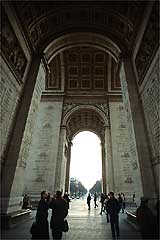
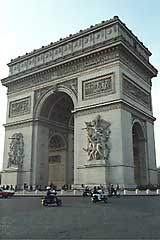 The
Arc de Triomphe is a huge, imposing monument with a large observation
deck. It has a great view of the city because it's on top of one of
the highest hills in Paris. We went up to the deck. An elevator speeded
our ascent. During our entire visit to Paris the temperatures were above
freezing but here it was windy and very cold. The view was worth it.
We could see several of the places we visited and picked out several
more that looked interesting. The private homes around here are palaces
and you look down onto their roofs and into their yards. Major streets
radiant from the Arc in every direction like the spokes of a wheel.
The view from the arc is the first photograph at the beginning of this
article.You can see a larger version of it
The
Arc de Triomphe is a huge, imposing monument with a large observation
deck. It has a great view of the city because it's on top of one of
the highest hills in Paris. We went up to the deck. An elevator speeded
our ascent. During our entire visit to Paris the temperatures were above
freezing but here it was windy and very cold. The view was worth it.
We could see several of the places we visited and picked out several
more that looked interesting. The private homes around here are palaces
and you look down onto their roofs and into their yards. Major streets
radiant from the Arc in every direction like the spokes of a wheel.
The view from the arc is the first photograph at the beginning of this
article.You can see a larger version of it  Versailles
is beautiful and worth the trip if you like old opulence. I wouldn't
go in the summer however. Outside the entrance are many stanchions and
chains. I asked the sales person in the ticket window about these. He
said they are used to make thousands of visitors wait hours in lines
before getting in. [In the summer.] We didn't wait at all because there
was no line.
Versailles
is beautiful and worth the trip if you like old opulence. I wouldn't
go in the summer however. Outside the entrance are many stanchions and
chains. I asked the sales person in the ticket window about these. He
said they are used to make thousands of visitors wait hours in lines
before getting in. [In the summer.] We didn't wait at all because there
was no line. Our
hotel was on the "Left Bank" of the river Seine. Out the window we saw
a French "bag lady" carrying many plastic parcels, some tied to her
body. Her image, mirrored in the window of an expensive leather boutique,
was a study in contrasts. Down at the corner she shuffled past two gendarmes.
I asked our concierge why they, or sometimes an entire busload of police,
were standing there 24 hours a day. He said the Prime Minister's home
is on the next block. The people of France have elected a government
that funds an extensive social service system. We saw that it succeeds
in having far fewer destitute people out in the public's eye than in
American cities. In France, only one in twenty children grows up in
poverty compared to one out of six in the United States. This means
fewer children grow up to become impoverished adults.
Our
hotel was on the "Left Bank" of the river Seine. Out the window we saw
a French "bag lady" carrying many plastic parcels, some tied to her
body. Her image, mirrored in the window of an expensive leather boutique,
was a study in contrasts. Down at the corner she shuffled past two gendarmes.
I asked our concierge why they, or sometimes an entire busload of police,
were standing there 24 hours a day. He said the Prime Minister's home
is on the next block. The people of France have elected a government
that funds an extensive social service system. We saw that it succeeds
in having far fewer destitute people out in the public's eye than in
American cities. In France, only one in twenty children grows up in
poverty compared to one out of six in the United States. This means
fewer children grow up to become impoverished adults. 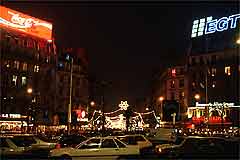 We
came up the Metro exit into a huge crowd of shoppers and hundreds of
stores and cafes. The aisles of C & A were jammed with people taking
advantage of the sale. I found my jacket. The situation was so normal
that Lynne and I momentarily forgot we were in a foreign country. This
feeling was strengthened when the teen-age salesclerk took my VISA card
and asked us questions in perfect English.
We
came up the Metro exit into a huge crowd of shoppers and hundreds of
stores and cafes. The aisles of C & A were jammed with people taking
advantage of the sale. I found my jacket. The situation was so normal
that Lynne and I momentarily forgot we were in a foreign country. This
feeling was strengthened when the teen-age salesclerk took my VISA card
and asked us questions in perfect English.